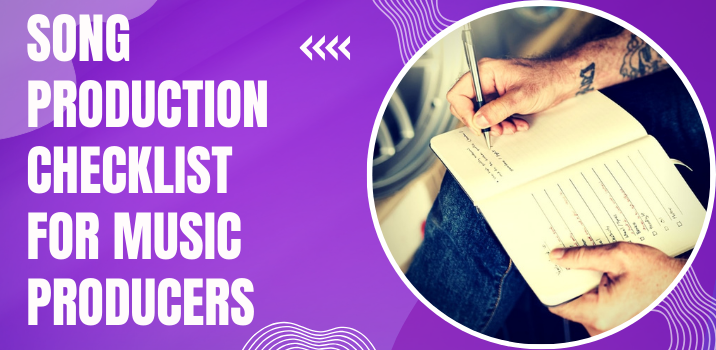Song production checklist for music producers

17-May-2024
Writing catchy lyrics and a captivating tune is not the only thing that goes into making a song memorable. Every stage of the music production process, from pre-production to mastering, necessitates meticulous attention to detail. Whether you're a novice or an experienced producer, a thorough checklist may help you stay organized and ensure nothing important is missed. In this blog, we assist you in confidently traversing the creative process. Here, we've outlined the song production checklist for music producers.
· Pre-Production Prewriting is the key element, which is the backbone of the whole production of the song. During this stage, we come up with ideas and find out what exactly we want to tell people. We create a plan and find all the materials we will use to tell our stories. Here's what to consider:
Conceptualize the song: What do you need to say? What are you trying to imitate or express through your music? Consider being clear about the theme, message, and mood you want to deliver.
Songwriting: Scan, or write, the lyrics, come up with the melody, and finally create the structure of the song arrangement.
Demo recording: Formulate a roughly drafted version of the track to achieve a general outline of the song and highlight the things that are projected to be modified.
Budgeting and scheduling: identify your production funds and organize a plan with a timeline for each stage.
· Recording
After pre-production, let's move to a studio to hold the event. The process of filming begins at this stage, involving the replication of the musicians, vocalists, and their performances. Here's what you need to do:
Select a recording studio: Consider the kind of studio you like to work in and how it is equipped to help you achieve optimal acoustics, as well as selections that would financially make sense to you.
Hire session musicians (if needed): The formation of a collaboration with instrumentalists of a good level will enable you to create a strong song.
Set up equipment: Check that all recording gear, e.g., microphones, instruments, and amplifiers, has been set up and is functioning appropriately before the session.
Record the basic tracks: Congrat the building blocks of the rhythm section, like drums, bass guitar, and rhythm parts.
Record vocals: Sing the vocal parts, paying attention to the expression and feeling just as they should be.
· Editing Creating good-sounding records requires a rich amount of post-production work, and maybe redoing tracks to comply with your musical vision is necessary. Here's what to focus on during the editing process:
Comp editing: meticulously editing out flubbed lines and combined multiple takes to create a single-take video editing.
Pitch correction: Ultimately, apply pitch correction software to the mix to alter the voice and instrumental pitches as much as possible.
Time alignment: Alter individual track timings in view of getting the rhythm more precise. Furthermore, you can:
Arrange transitions: Add transitions between parts of the song to keep it coherent and whole.
· Mixing It's partly about layering or combining individual tracks, which in the end should become a melodic and harmonious landscape. Here's how to approach the mixing stage:Here's how to approach the mixing stage:
Balance levels: Try out different ratios for each track to achieve an even sound effect.
Equalization (EQ): Selecting EQ as a tool to sculpt the frequency spectrum and boost the clarity and presence of each specific instrument are good examples that I will be using.
Compression: Apply compression to control the character of music and always get the desired result when the song is heard.
Effects processing: Use reverb, delay, space depth, and other spaces to create ambiance and depth.
Automation: Automate volume, movement, and effect parameters to add to the mix a degree of originality that will be appealing to the listener.
· Mastering During the last phase of the song-creation process, the song is remastered if required, and it is deciphered for distribution. Here's what mastering entails:
Audio mastering engineer: Collaborate with the best mastering engineer who has proven to thrive in producing well-drilled master copies.
Loudness optimization: Make up for the song's maximum level that is expected to be played back.
EQ adjustments: Work on the fine-grained frequency curve to achieve the best sound quality in all playback systems.
Dynamic processing: Apply multiband compression, limitation, and other dynamic processing techniques either for clarity or punch.
Sequencing: Once the flow of an album or EP is determined, add songs to reflect the order of release.
Conclusion
Generating a song is by no means just a routine duty, as it entails thorough planning coupled with vision and technical knowledge. With the use of this all-encompassing checklist, the music producers can go further and be sure that they have taken each stage of the production process carefully and securely. Regardless of whether you are an old pro or a budding talent, attention to detail and commitment are vital elements for further progress. Through determination and resilience, you can turn your sounds into a reality that can take your audience to another universe with your affirmation, splendor, and mounting streams.